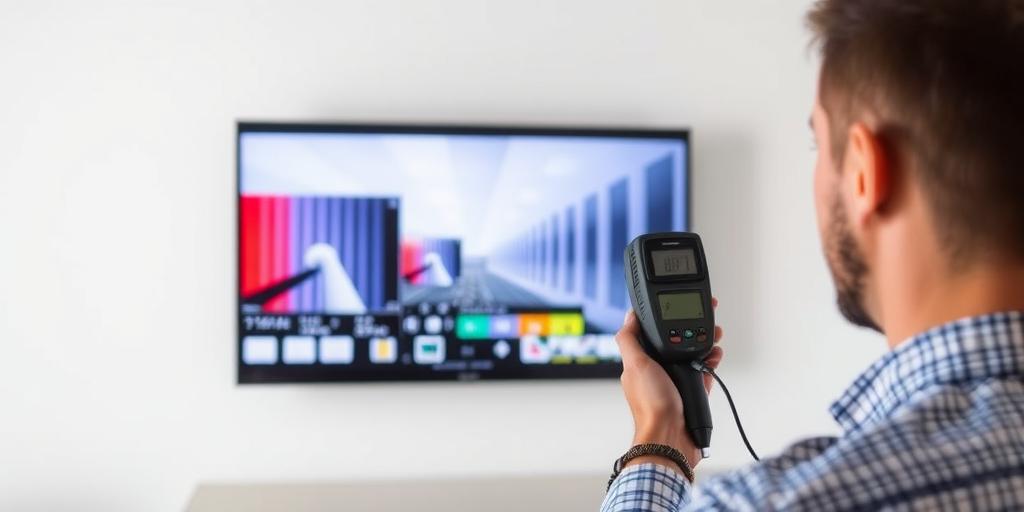How to Calibrate Your TV for the Best Picture Quality
Getting the best possible picture quality from your TV involves more than just plugging it in. Calibration is key to unlocking its full potential, ensuring accurate colors, optimal contrast, and overall stunning visuals. This guide will walk you through the steps to calibrate your TV, whether you're using built-in settings, calibration tools, or professional assistance.
Why Calibrate Your TV?
Out of the box, TVs are often set to 'vivid' or 'dynamic' modes, which boost brightness and colors to attract attention on store displays. These settings aren't accurate and can lead to eye strain and a poor viewing experience. Calibrating your TV ensures:
- Accurate Colors: See colors as the content creators intended.
- Optimal Contrast: Experience deeper blacks and brighter whites.
- Improved Detail: Reveal subtle details in shadows and highlights.
- Reduced Eye Strain: Comfortable viewing for extended periods.
Step-by-Step Guide to TV Calibration
1. Understanding Your TV's Settings
Familiarize yourself with the basic picture settings menu. Common settings include:
- Picture Mode: Choose a starting point like 'Movie,' 'Cinema,' or 'Calibrated.'
- Brightness: Adjust the overall luminance of the screen.
- Contrast: Control the difference between the brightest and darkest parts of the image.
- Color: Adjust the intensity of the colors.
- Tint: Correct color imbalances, typically red or green.
- Sharpness: Control the clarity of edges and details.
- Backlight: Adjust the brightness of the TV's backlight (especially useful for HDR content).
2. Using Built-In Calibration Tools
Many modern TVs come with built-in calibration tools or picture presets designed to improve image quality. Look for these in your TV's settings menu:
- Auto Calibration: Some TVs offer automated calibration using a built-in sensor or an app.
- Picture Wizards: Step-by-step guides to adjust settings using test patterns.
- Preset Modes: Explore modes like 'Filmmaker Mode,' which aims to display content as the director intended.
3. Manual Calibration with Test Patterns
For more precise calibration, use test patterns. These are images designed to help you adjust specific settings. You can find test patterns on Blu-ray discs, streaming services, or online.
Basic Test Patterns and Adjustments:
- Brightness: Use a black clipping pattern to set the brightness so that the darkest shades are just visible.
- Contrast: Use a white clipping pattern to set the contrast so that the brightest shades are clear without being washed out.
- Color and Tint: Use color bar patterns to adjust the color and tint until the colors appear balanced and accurate.
- Sharpness: Use a sharpness pattern to reduce over-sharpening, which can cause unwanted artifacts.
4. Advanced Calibration with External Tools
For enthusiasts seeking the highest level of accuracy, consider using external calibration tools:
- Colorimeter: A device that measures the colors displayed on your screen.
- Calibration Software: Software that works with a colorimeter to generate calibration profiles.
These tools can automatically adjust your TV's settings to achieve professional-grade accuracy. Popular options include Calman, DisplayCAL, and X-Rite i1Display.
5. Optimizing for Different Content
Keep in mind that different types of content may benefit from slightly different settings. For example:
- Movies: Use 'Movie' or 'Cinema' mode for the most accurate colors and contrast.
- Gaming: Use 'Game' mode to minimize input lag and optimize response time.
- Sports: Use a brighter mode with smooth motion settings for fast-paced action.
6. Professional Calibration
If you want the best possible results without the hassle of DIY calibration, consider hiring a professional calibrator. They have the expertise and equipment to fine-tune your TV to its optimal performance.
Key Calibration Considerations
- Room Lighting: Calibrate your TV in the lighting conditions you typically watch it in.
- Content Source: Use a high-quality source like Blu-ray or 4K streaming for calibration.
- Eye Comfort: Adjust settings to reduce eye strain and ensure comfortable viewing.
Conclusion
Calibrating your TV is a worthwhile investment of time that can significantly improve your viewing experience. Whether you use built-in tools, test patterns, or professional services, the result is a picture that's more accurate, detailed, and enjoyable. Take the time to fine-tune your TV, and you'll be amazed at the difference it makes.









